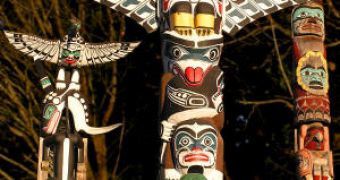The word "totem" comes from the Ojibwa, an Algonquin language from the north of the Great Lakes of North America. "Ototeman" would mean "he is of my clan". The totem would express the belonging to a clan. Totem was an animal or plant, rarely an object, believed by a tribe to be its ancestor or protector, and therefore being worshiped.
The wood carved totem poles of the tribes of western coast of North America were famous. Vey few can be found today, like in the British Columbia, close to the border with Alaska, like in the Kitwanga village.
They usually depicted animals with horrid expressions. The totemic religion was based on the faith that animals can turn into humans and vice-versa. The items were common amongst the Red Skins of North America and Polynesians. The Indians made totemic poles up to 20 m (66 ft) tall, and raised with various occasions: the death of a chief, the inauguration of a new collective house, family celebrations and so on. The importance and community feeling of the events were expressed through size, color and richness of the carvings, but also by the type of the represented animals.
As the Amerindians did not know writing, the totems could be "read" as historical events and legends, otherwise lost. Because of their life in tight connection with the nature, the totem makers knew very well the behavior of the totem species. Almost all the animals - like sea otters, beavers, wolves, bears, eagles, ravens, frogs, seals and others - represented in totems could be hunted, but under certain conditions, and respecting some taboos.
These animals were symbols with supernatural powers and their consideration inside the community varied depending on the clan, and its chosen totemic animal.
One common totem was the Thunder Bird (Kwun-Kwane-kulegyi), a type of horrible condor, considered master of the sky and land. It helped people raise their houses and its power was feared. Now, scientists identify the Thunder Bird with Teratorn, a huge North American bird with a wingspan of around 3.5 to 3.8 meters (11 to 12 feet), standing an estimated 75 cm (2.5 ft) tall and weighing about 15 kg (33 pounds). It was distantly related to condors and ate carrion or hunted animals. Children could have been an easy prey as well, and the birds disappeared a few thousands years after the ancient Indians entered North America.
The raven (Kwaw'wine) was considered the creator of the world and the light bringer. Legends describe it as wise and powerful. It even stole from the beaver a lake filled with salmons offered to the Great Chief Gal-Gum-Gas-Su to feed his people. Thus, the raven was considered to favor rich captures of salmon.
In the case of the beaver totem, the adults were represented very realistic, but the beaver offspring was often represented with a human head.
Both North American bears, the black bear and the grizzly (brown) bear are represented with long claws, lolling tongue and very large nostrils. The giant grizzly impressed more, as it was always represented with its terrible teeth (symbols of cruelty and power). This species was considered protector of the house and in a legend it is described as a charming prince who will marry the most beautiful girl of the tribe. Bears were often represented with a captured salmon.
The orca or killer whale (Marhenurh) is a sinister spirit for the Indians, an evil tyrant of the sea, able to kill even the Thunder Bird. The orca was represented with its large teeth and... gills, as Indians believed all the water creatures had gills, and land animals ears.
Totem animals were represented not only on poles, but also on personal objects and even animal masks (like in the case of the Haida Indians). Animals having human traits and vice versa symbolized the passing human-animal.
One totem represented a weeping man whose tears reach the upper head of two small children at his feet while he gently caresses a frog. The legend says the man went one day to hunt on the island of Queen Charlotte (off the Canadian shore) together with his 7 children and 2 grandchildren. While the adults were hunting, the 2 kids put a frog found nearby on a fire. The frog swelled and exploded. Fascinated, the kids repreated this, until the chief found out what was happening. This was a sacrilege, and the chief urged them all to the canoe, to leave the place. It was too late, as the Earth opened, swallowing them all. The only survivor was the old chief, the weeping man. His tears represent the end of his kin, the end of a world in which people respected animals. A symbol of the break between humans and their environment.

 14 DAY TRIAL //
14 DAY TRIAL //